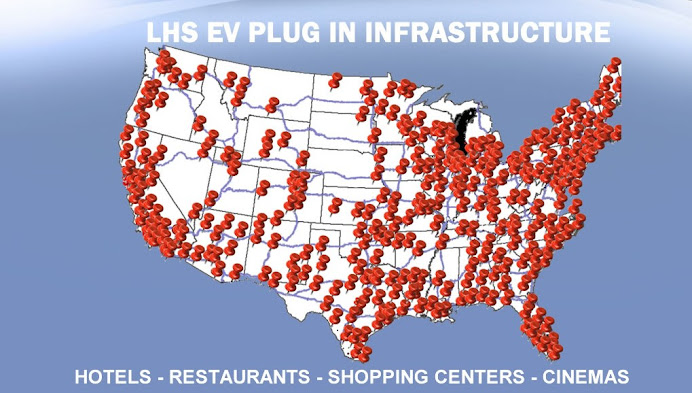 Electric vehicles are no longer a technology of the future. Californians will be driving the Nissan Leaf and Coda Sedan by the end of the year, and several other automakers have all-electric and plug-in hybrid models in the pipeline.
Electric vehicles are no longer a technology of the future. Californians will be driving the Nissan Leaf and Coda Sedan by the end of the year, and several other automakers have all-electric and plug-in hybrid models in the pipeline.
Now the race is on to build electric vehicle charging stations, where drivers can pull up and plug in their cars.
Several companies, including Coulomb Technologies in Campbell, Better Place in Palo Alto and ClipperCreek in Auburn, see enormous opportunity in the development of electric-vehicle infrastructure.
"Now that the world has decided this is a business, everyone wants in," said Richard Lowenthal, Coulomb's co-founder and CEO, who first drove an electric car when he served as mayor of Cupertino. "We need charging stations. That's our business."
Electric cars currently can travel only a limited number of miles before the batteries need to be recharged, leading to what is known in the industry as "range anxiety." And while most owners are expected to charge their vehicles overnight at home, some apartment dwellers and others may not have that convenience. "People are scared to death of getting stranded on the highway and not knowing what to do. You can't call a friend and say, 'Can you bring me a gallon of gas?' " said Jason Rissanen, a partner in Deloitte's cleantech practice who focuses on electric cars. "This is an emerging market, and people naturally want a buffer range."
There are two solutions to range anxiety: better batteries and charging stations.
Coulomb is creating charging stations that are far more than parking poles with electricity. The company's ChargePoint Network includes features like trip planning and an iPhone application that gives directions to available charging stations. The idea is that drivers will sign up for a monthly ChargePoint Network pass and can swipe a card to pay for charging sessions. Coulomb currently has 136 ChargePoint stations installed in the United States. In the Bay Area, they can be found in several locations, including San Jose City Hall and San Francisco City Hall. Martinez recently installed three ChargePoint stations downtown and at the city's Amtrak station. The charging stations are essentially an extension of the so-called "smart" electric grid, and are able to communicate with one another and with the utilities through sophisticated software. Daniel Ahn, a partner at Voyager Capital and an investor who sits on Coulomb's board, said many venture capitalists in Silicon Valley have poured money into companies like Tesla Motors, which makes electric cars, without thinking of the infrastructure needed to support them.
"If you look at the EV space, you've got the cars themselves, and the batteries," Ahn said. "Coulomb has a broad vision around networked energy, and the 'Aha!' moment for me was thinking about the network effect." The company, which was founded in 2007, raised $14 million in second-round venture funding earlier this year and has 60 employees.
Better Place, which has received a lot of publicity around its concept of battery-switching stations, is also working on a network of charge spots for workplaces and public parking lots. "Most of these cars are getting in the 100-mile range, and if you have a ubiquity of charge spot coverage, most people will be able to 'top off,' or recharge enough to get to their destination," said Better Place representative Julie Mullins. "Battery switching is really for the longer drive."
Better Place already has 1,000 charge spots in Israel, its key market so far.
This summer, the nascent U.S. electric-vehicle infrastructure will expand. Arizona, California, Tennessee, Oregon and Washington are all part of the Department of Energy-funded EV Project, which hopes to glean how electric vehicles perform in different climates. The $100 million federal stimulus grant will allow more than 11,000 charging stations, including more than 6,000 public charging stations, to be installed in test cities. San Diego is the only California city currently part of the EV Project, but that may change.
More than 7,000 people have paid $99 to reserve an all-electric Nissan Leaf, and customers should be driving them by the end of the year. Nissan thinks most Leaf customers will buy and install a home charging station or dock, but the automaker is eager to see public stations as well."Rome was not built in a day, and the integration of EVs and charging stations will not happen overnight, either," said Nissan representative Tim Gallagher. "But in our judgment, between home and public stations most customers will have the peace of mind they need." Some current electric-vehicle drivers think the focus on charging stations is overblown.
"We drive unconsciously today because there are gas stations on every corner," said Zan Dubin Scott of the advocacy group Plug In America. "The fact is that if you are in an electric car, there will be a range limit. I've driven an electric car for eight years with very limited infrastructure, and it hasn't been a big problem. I charge at home, and I live in Santa Monica, where there is free charging at my local shopping center. The solution is planning."
Source: Mercury News, by Dana Hull, May 1st, 2010
.jpg) Tata Motors may launch diesel hybrid variants of Jaguar XJ and XF models in the Indian market.
Tata Motors may launch diesel hybrid variants of Jaguar XJ and XF models in the Indian market..jpg)
.jpg)
.jpg)

.jpg)
